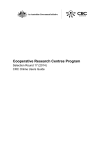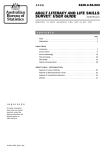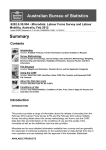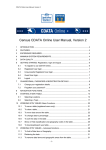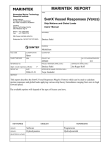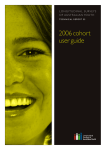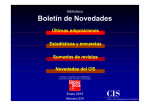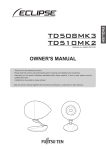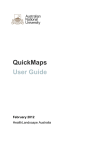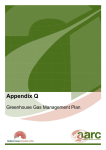Download AUSSA 2011 USER GUIDE - Australian Data Archive
Transcript
AUSTRALIAN SURVEY OF SOCIAL ATTITUDES 2011
USER GUIDE
This purpose of this user guide is to give a brief explanation of the Australian Social Survey (AuSSA)
2011 dataset.
Contents
Abstract .................................................................................................................................................2 Sample information ..............................................................................................................................3 Missing codes .......................................................................................................................................4 Data quality ...........................................................................................................................................4 Weighting ..............................................................................................................................................6 Citing the survey...................................................................................................................................9 APPENDIX A: STATA code used to generate weights ....................................................................10 Page | 1
Abstract
The 2011 Australian Survey of Social Attitudes (AuSSA) is the fifth in a biennial series that studies
social attitudes and behaviour of Australian citizens for the Australian and international research
community. AuSSA provides cross-sectional data on the social attitudes and behaviour of Australians,
repeating a core questionnaire for each cross-section and fielding specific modules relevant to the
changing needs of the social research community. AuSSA is Australia's official survey in the
International Social Survey Program and regularly includes ISSP modules. AuSSA 2011 includes both
the ISSP's Environment III (2010) and Health (2011) modules.
The 2011 Survey includes attitudes and behaviours that are organised into seven categories: Issues
facing Australia today; Environment; Health; Government Policy and services; Kindness; Australians
in History; and The Law and Authority.
AuSSA 2011 also includes demographic and behavioural categories (Personal Background) that
survey: sex, year born, income, education, employment, union membership, country of birth,
household composition and religion. There are also questions about the partner of the respondent:
employment, highest-level of education and income.
Page | 2
Sample information
Over 6,000 individuals were sampled from the 2011 Electoral Roll. Within each state, individuals were
chosen using systematic random sampling. The table below displays some information regarding the
response rates and the dates of fieldwork.
To minimise sample losses several actions were taken. One week before the questionnaires were
mailed out a pre-letter introducing the survey was sent. Around one and a half weeks after the
questionnaires were mailed, a reminder postcard was sent. Replacement questionnaires were sent to
respondents who had misplaced or lost their original questionnaires but were willing to participate in
the survey. A second reminder postcard was sent approximately one month after the first mail-out of
the questionnaires.
TABLE 1. SAMPLE INFORMATION AND FIELDWORK DATES
AuSSA 2011
Sample size
Final number of respondents
6,250
1,946
AAPOR Response Rate 1
Cooperation Rate 1
Contact Rate 1
31 %
68 %
46 %
Less than half of questionnaire filled in
Cannot complete due to language
Blank questionnaire returned
Known respondent refusal
Respondent unavailable during field period
Death
Physically or mentally unable/incompetent
Addressee Not Known at Place of Address
Nothing ever returned
Duplicate listings
2
5
794
37
15
16
34
515
2881
5
Dates of fieldwork
Pre-letter sent
Questionnaire mailed out
Reminder postcard
Replacement questionnaires mailed out
Second reminder postcard sent
Close
1-May-12
8-May-12
15-May-12
30-May-12
6-Jun-12
8-Aug-12
Page | 3
Missing codes
All missing codes in the dataset are assigned to negative numbers. The following missing codes are
used:
-1 Missing Used when the respondent was did not provide an answer to a question.
-2 Skip: Used when the respondent was not asked a particular question because it did not apply to
them and they had therefore been filtered away from it.
-4 No partner: Used in questions relating to partner’s characteristics, in cases where the
respondent did not have a partner. A respondent was classified as not having a partner if they
were not living with a partner or if the question on living with a partner was missing (h20).
-5 Multiple response: Used when the respondent was meant to give one response only, but
instead gave multiple responses. For example in variable a1 respondents were asked to choose
who they thought was the most important issue for Australia today. People who gave multiple
responses chose more than one option e.g. both health care and education.
-6 Illegible or impossible value: Used when the respondent did provide some information but it
was too faint to read, or it was an impossible value. For example a response of 300 for height
(c28). The purpose of this variable is to differentiate cases were something was written from those
with unit non-response (-1 missing).
-7 Don’t know: This was used in a few instances where the respondent had written a note on the
questionnaire indicating they did not know. Also used for the height and weight variables (c28 &
c29).
Data quality
Variables h42 and h43 (income) should be used with caution. A large number of respondents had
difficulty interpreting and answering these questions leading to poor quality of data.
Page | 4
Australian Bureau of Statistics (ABS) classifications
The following ABS classifications were used for selected variables.
Topic
Variables
ABS coding standard
Country of birth
h36o
h37o
h38o
SACC- Standard Australian
Classification of Countries, 2011
Respondent country of birth
Mother’s country of birth
Father’s country of birth
h39oa Ancestry – other 1
Ancestry
h39ob Ancestry – other 2
occupation_l1
occupation_l2
occupation_l3
occupation_l4
Respondent’s
occupation
Occupation
poccupation_l1
poccupation_l2
poccupation_l3
poccupation_l4
industry_l1
industry_l2
industry_l3
industry_l4
Industry
pindustry_l1
pindustry_l2
pindustry_l3
pindustry_l4
Partner’s
occupation
Industry of
respondent’s
place of work
ASCCEG- Australian Standard
Classification of Cultural and Ethnic
Groups, 2011
ANZSCO - Australian and New
Zealand Standard Classification of
Occupations, First Edition, Revision 1
ANZSIC- Australian and New Zealand
Standard Industrial Classification ,
2006, Revision 1.0)
Industry of
partner’s place of
work
Page | 5
Weighting
Responses were biased toward women, the more highly educated and older people. To correct for
these biases, the AuSSA 2011 sample has been benchmarked against the Census 2011 data on
Australian citizens, following the procedure and the STATA code used by Trevor Breusch (2004) for
the 2003 AuSSA data. The weighted sample is designed to have the same proportions as the Census
in a three-way cross-tabulation of age, sex, and educational attainment.
AuSSA 2011
Census
Sample %
Expected %
Age
18-29
8
20
30-39
10
17
40-49
16
19
50-64
34
25
65+
30
18
Missing
2
Total
100
100
Male
47
49
Female
52
51
Missing
1
Sex
Total
100
100
Less than Year 12
23
32
Year 12
8
18
Trade, certificate, diploma
33
30
Bachelor degree
Postgraduate degree or diploma
15
16
15
6
Missing
4
Highest education
Total
100
100
The cross tabulation by age, sex and highest education level from the Census was done using the
2011 Census Table Builder. A table was created using sex and age (single years) in the rows, and
Australian Citizenship, Highest level of education and highest year of school completed in the
columns. The final table was created by excluding those who did not have Australian citizenship (this
included those who did not state their citizenship). Individuals with postgraduate degrees and
graduate diplomas were combined into one category. Individuals with certificates or
diplomas/advanced diplomas were also combined into one category. Those who were recorded as
having their highest non-school qualification as inadequately described, not stated or not applicable
were assumed not to have a post-school qualification and were coded according to their highest level
of school education. Those who had had completed Year 12 were coded as having completed highschool education. Those who completed up to Year 11 or below (included those who did not state
their highest level of school education) were coded as having not completed high school.
Page | 6
Constructing sampling weights
The sampling weights are designed to rebalance the sample so the weighted sample frequencies are
equal to the expected frequencies in the three-way tabulation by age group (five groups), sex, and
educational attainment (five levels).
Only 1,834 of the 1,946 observations had complete information on all three of these variables.
Imputation of missing data was possible in some cases however. Where educational attainment was
missing but occupational category was available, for the purposes of constructing the weights, people
were given the most common education level for their occupation (irrespective of their age).
When age was missing, in some cases, this was imputed from other information available in the
questionnaire. If there was information on the respondents main activity they were given the average
age of people with the same activity (e.g. if the respondent was retired, they were given the average
age of retired people).
For people who were missing on gender, they had a weight allocated to them that was the average of
the weights over gender for their education and age. To avoid extreme weights, the weights were
trimmed at the 1 per cent and 99 per cent level, before being rescaled so that they averaged to one
across all cases in each subsample.
The average calculated weights are shown in the following table:
Highest education
Not
complete
high school
Complete
high
school
Certificate
or diploma
Bachelor
degree
Postgraduate
degree or
diploma
18-29
Male
Female
5.73
5.73
3.92
5.73
1.94
1.20
1.56
1.21
0.84
0.91
30-39
Male
Female
5.73
5.57
2.75
3.52
2.36
1.35
1.41
1.53
0.67
0.47
40-49
Male
Female
1.80
2.69
2.68
1.86
1.06
0.84
0.96
0.81
0.35
0.53
50-64
Male
Female
1.08
1.24
1.01
1.43
0.73
0.48
0.87
0.58
0.33
0.21
65 and over
Male
Female
0.53
0.89
0.68
1.08
0.61
0.29
0.48
0.53
0.16
0.15
Sex and age
Page | 7
The effects
For most variables the effect of weighting is only moderate.
[H31] Frequency of attending religious services
Several times a week or more often
Once a week
2 or 3 times a month
Once a month
Several times a year
Once a year
Less frequently than once a year
Never
Missing
Total
Unweighted
(%)
2
11
3
3
12
7
17
Weighted
(%)
2
9
3
2
12
7
16
42
3
100
44
6
100
*Total may add up to more than 100, due to rounding
For other variables more closely related to age, sex or highest education the effect of weighting is
more noticeable, as with the example of home ownership.
[H46] Own or rent dwelling
Own outright
Own, paying off mortgage
Rent from private landlord
Rent from public housing authority
Other (boarding, living at home, etc)
Missing
Total
Unweighted
(%)
46
31
11
3
6
3
100
Weighted
(%)
34
34
12
3
12
6
100
*Total may add up to more than 100, due to rounding
Page | 8
Citing the survey
To cite the survey, please use the following:
Evans, A. Australian Survey of Social Attitudes 2011, The Australian National University:
Australian Demographic & Social Research Institute, 2011
For further information regarding the survey please visit the website:
http://aussa.anu.edu.au/index.php
Page | 9
APPENDIX A: STATA code used to generate weights
**********************************************************
* Name: weight_final.do
* Purpose: Sampling Weights for AuSSA 2011
*
* Author: Anna Reimondos - adapted from Trevor Breusch
*
weights used in 2003 AuSSA
* Date: November 2012
* Stata version: 12.1
**********************************************************
* Weight for age group, gender and education attainment
preserve
capture drop gender
clonevar gender=h1
*Gen tempage group
capture drop tempage
gen tempage=age
replace tempage=. if tempage==-1
*If age is missing estimate based on average for that sex*retired
capture drop retired
gen retired=.
replace retired=1 if h19==6
replace retired=0 if h19!=6 & h19!=.
mean(tempage), over(gender retired)
replace tempage=48 if gender==1 & retired==0 & tempage==.
replace tempage=73 if gender==1 & retired==1 & tempage==.
replace tempage=47 if gender==2 & retired==0 & tempage==.
replace tempage=71 if gender==2 & retired==1 & tempage==.
*If retirement missing use partner's retirement?
gen pretired=.
replace pretired=1 if h28==6
mean(tempage) if pretired==1, over(gender)
replace tempage=72 if gender==1 & pretired==1 & tempage==.
replace tempage=69 if gender==2 & pretired==1 & tempage==.
*Otherwise just use average
mean(tempage) ,over(gender)
replace tempage=56 if gender==1 & tempage==.
replace tempage=54 if gender==2 & tempage==.
mean(tempage), over(retired)
replace tempage=48 if gender==. & tempage==. & retired==0
replace tempage=71 if gender==. & tempage==. & retired==1
mean(tempage)
replace tempage=55 if gender==. & tempage==. & retired==.
gen age_gp=.
replace age_gp=1
replace age_gp=2
replace age_gp=3
replace age_gp=4
replace age_gp=5
tab age_gp,m
if
if
if
if
if
tempage>=18
tempage>=30
tempage>=40
tempage>=50
tempage>=65
&
&
&
&
&
tempage<=29
tempage<=39
tempage<=49
tempage<=64
tempage<=105
label define age_gp ///
Page | 10
1
2
3
4
5
"18-29"
"30-39"
"40-49"
"50-64"
"65+"
///
///
///
///
label values age_gp age_gp
*
*
*
*
*
*
EDUCATION ATTAINMENT.
We separate bachelor and postgraduate qualifications (because we can,
although that means combining ABS categories) but we combine
trade/certificate/diploma (because we are uncertain that AuSSA
categories match ABS ones)
capture drop edimp
gen edimp=.
replace edimp=1 if
replace edimp=2 if
replace edimp=3 if
replace edimp=4 if
replace edimp=5 if
highed==1
highed==2
inlist(highed,3,4)
inlist(highed,5) & h6==6
inlist(highed,5) & inlist(h6,1,2,3,4,5)
label
label
label
label
label
label
1 "< Year 12", modify
2 "Year 12", modify
3 "Certificate or diploma", modify
4 "Bachelors", modify
5 "Postgraduate", modify
edimp
define
define
define
define
define
values
edimp
edimp
edimp
edimp
edimp
edimp
*(1)Give each person with missing education the most common for their
* occupational group (irrespective of tempage)
tab edimp occupation_l1, col nofreq
* These
replace
* These
replace
* These
replace
* These
replace
are the
edimp=3
are the
edimp=5
are the
edimp=3
are the
edimp=1
managers (5 changes)
if occupation_l1==1 & edimp==.
professionals (4 changes)
if occupation_l1==2 &edimp==.
technicians until sales workers(22 changes)
if inlist(occupation_l1,3,4,5,6) &edimp==.
lower occupations (8 changes)
if inlist(occupation_l1,7,8)
&edimp==.
*(2)For people with unstated education and occupation, give them the
* lowest level of education
replace edimp=2 if edimp==. & h5==1
replace edimp=1 if edimp==.
*(3)More treatment of missing data below, after weights are calculated
tab edimp,m
* Set up matrices for population and sample counts
* Rows `i' age_gp=1/5, then gender=1/2
* Cols `j' edimp=1/5
gen rindex=2*(age_gp-1)+gender
gen cindex=edimp
mat input ABS=(277721
205638 486886 381275 252856
207646 198392 441204 213950
200797 227990 359292 307909
325065 154443 486846 179355
479757 419457 168877 24134\ ///
39508\ ///
81514\ ///
105931\ ///
92138\ ///
Page | 11
406376
511216
766073
506622
878947
matrix
200985 376797
203430 626392
216740 414506
122333 372363
155307 162661
list ABS
228709
212093
230665
87074
83535
102908\ ///
118190\ ///
117222\ ///
43686\ ///
27974)
* Construct an equivalent matrix of sample values
tab gender edimp if age_gp==1, matcell(N1)
tab gender edimp if age_gp==2, matcell(N2)
tab gender edimp if age_gp==3, matcell(N3)
tab gender edimp if age_gp==4, matcell(N4)
tab gender edimp if age_gp==5, matcell(N5)
mat R=N1\N2\N3\N4\N5
matrix list R
*Calculate totals of all cells in matrices
sca sumABS=0
sca sumR=0
forval i=1/10 {
forval j=1/5 {
sca sumABS=sumABS+ABS[`i',`j']
sca sumR=sumR+R[`i',`j']
}
}
* Weight is ratio of population relative cell count to sample
* relative cell count
gen weight=.
forval i=1/10 {
forval j=1/5 {
qui
replace
weight=(ABS[`i',`j']/sumABS)/(R[`i',`j']/sumR)
rindex==`i'&cindex==`j'&R[`i',`j']~=0
}
}
if
* More treatment of missing data
* (3)For those with missing gender, give them the average weight for
* their other characteristics
replace rindex=2*(age_gp-1)+1 if gender==.
forval i=1(2)10 {
forval j=1/5 {
replace
weight=((ABS[`i',`j']/sumABS)/(R[`i',`j']/sumR)+(ABS[`i'+1,`j']/sumABS)/(R[`i'+1,`j
']/sumR))/2 if rindex==`i'&cindex==`j'&weight==.
}
}
* Weights should average=1.0000
summ weight
summ weight, detail
*Trim at 1 and 99% percentile
replace weight=5.9 if weight>5.9
replace weight=0.15 if weight<0.15
sum weight
sum weight, detail
egen sumw=sum(weight)
replace weight=weight*1946/sumw
summ weight
label var weight "Sampling weight"
* Display the weights by gender, education and tempage group
Page | 12
by
by
by
by
by
tab
tab
tab
tab
tab
tab
gender,s:
gender,s:
gender,s:
gender,s:
gender,s:
tab
tab
tab
tab
tab
weight
weight
weight
weight
weight
edimp
edimp
edimp
edimp
edimp
if
if
if
if
if
age_gp==1
age_gp==2
age_gp==3
age_gp==4
age_gp==5
age_gp
age_gp [aw=weight]
gender,m
gender [aw=weight],m
edimp,m
edimp [aw=weight],m
table age_gp edimp, contents(mean weight ) by(gender)
capture drop gender tempage age_gp educ edimp rindex cindex sumw
keep formid weight
save weight.dta, replace
Page | 13













